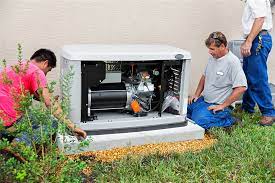When installing a new generator, make sure to check local codes to ensure proper placement. In general, the generator must be located at least 18 inches from the nearest wall, 50 inches from doors and air intakes, and 3 feet away from flammable materials. Ask about insurance and licensing, and check for references. You can also ask about subcontracting and unexpected costs.
 Generator installation should be done outside of the home to reduce the risk of electrical fire. If a generator breaks down inside, carbon monoxide and smoke can be released and spread quickly indoors. Ideally, your generator should be located at least 20 feet away from your house and in a secure location. In addition, you should make sure the generator is out of the way of any children or pets. Visit Long Island Emergency Power for more details.
Generator installation should be done outside of the home to reduce the risk of electrical fire. If a generator breaks down inside, carbon monoxide and smoke can be released and spread quickly indoors. Ideally, your generator should be located at least 20 feet away from your house and in a secure location. In addition, you should make sure the generator is out of the way of any children or pets. Visit Long Island Emergency Power for more details.
When you hire a generator installation team, make sure they have the proper licensing and experience. A good team will include a certified gas professional and a small crew to pour concrete. A typical generator installation will cost from a few thousand dollars to $9,500, depending on the type of installation you need. The price includes all parts and installation. Maintenance of the generator can cost another $200 to $300 a year, so make sure you know what you’re getting into before you make a final decision.
In addition to a properly-installed generator, generators need a level surface to avoid potential damage. A concrete pad should be installed under the generator for safety and efficiency reasons. You should also use a thicker concrete pad if your generator is larger. Some companies offer composite concrete pads that are more weight-efficient and have predrilled holes for mounting the generator.
Lastly, you should consider which appliances you will need to connect to your generator. The biggest loads in a house are heat and air conditioning. However, if you don’t need air conditioning or have an extra bathroom, you can leave out these appliances and reduce the size of your generator. It’s also helpful to know the wattage of your appliances.
In addition to a generator, you should also consider whether you’ll need a transfer switch. This switch detects when there’s a power cut and switches off the generator’s power. It can be installed ahead of the main electrical panel, or behind it. In addition, it can be connected to a smaller sub-panel.
When installing a generator, it’s important to follow local and state regulations. Failure to do so can result in lawsuits and financial penalties. Some states require that generators be placed at least 18 inches away from a home or building for safety and aesthetic reasons. If you’re unsure, contact the local permit office to learn more about requirements. You’ll also need to ensure the generator’s placement is safe and level.
When installing a generator, it’s important to know how much power you use on a daily basis. This will help you determine the correct size for your home. Remember that a smaller size might be sufficient for just one large appliance, while a larger size might be required for all of your lights and appliances.